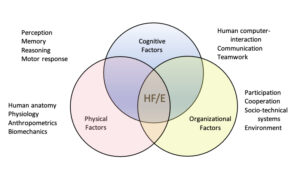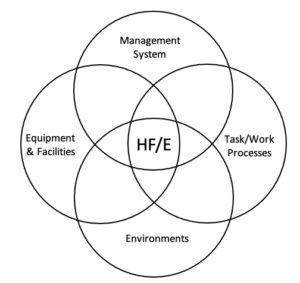What is Ergonomics?
Definition and Applications
The word ergonomics —“the science of work” — is derived from the Greek ergon (work) and nomos (laws). The terms ergonomics and human factors are often used interchangeably or as a unit (e.g., human factors / ergonomics – HFE or EHF) a practice that is adopted by the IEA. The definition of ergonomics (or human factors) adopted by the IEA in 2000 is the scientific discipline concerned with the understanding of interactions among humans and other elements of a system, and the profession that applies theory, principles, data, and methods to design in order to optimize human well-being and overall system performance.
Domains of HFE were also defined in 2000 to include – Physical ergonomics is concerned with human anatomical, anthropometric, physiological and biomechanical characteristics as they relate to physical activity. (Relevant topics include working postures, materials handling, repetitive movements, work-related musculoskeletal disorders, workplace layout, physical safety and health.)
Cognitive ergonomics is concerned with mental processes, such as perception, memory, reasoning, and motor response, as they affect interactions among humans and other elements of a system. (Relevant topics include mental workload, decision making, skilled performance, human-computer interaction, human reliability, work stress, and training as these may relate to human-system design.)
Organizational ergonomics is concerned with the optimization of sociotechnical systems, including their organizational structures, policies, and processes. (Relevant topics include communication, crew resource management, work design, design of working times, teamwork, participatory design, community ergonomics, cooperative work, new work paradigms, virtual organizations, telework, and quality management.)
Although HFE practitioners often work within particular economic sectors, industries, or application fields, the science and practice of HFE is not domain-specific. HFE is a multi-disciplinary, user-centric integrating science. The issues HFE addresses are typically systemic in nature; thus HFE uses a holistic, systems approach to apply theory, principles, and data from many relevant disciplines to the design and evaluation of tasks, jobs, products, environments, and systems. HFE takes into account physical, cognitive, sociotechnical, organizational, environmental and other relevant factors, as well as the complex interactions between the human and other humans, the environment, tools, products, equipment, and technology.

In order to practice effectively, human factors and ergonomics professionals who are specialists in a given domain or discipline must address issues and challenges with sufficient consideration of all of the relevant elements of HFE. This assumes a broad understanding of other HFE areas; however, actual problem solving requires participatory approaches through consultation with HFE specialists in different domains as well as specialists in other relevant fields.
HFE Principles
HFE principles are rooted in socio-technical values. HFE participatory design principles and methodologies apply across the design of tasks, jobs, products, environments, industries and types of work. HFE principles are rooted in essential core values-2,3
- humans as assets
- technology as a tool to assist humans,
- promotion of quality of life,
- respect for individual differences, and
- responsibility to all stakeholders.
HFE Perspectives
HFE encompasses not only physical safety and health but also the cognitive and psycho-social aspects of living and working. Additionally, HFE can focus on microergonomic aspects of design – including design of the procedures, the context, and the equipment and tools used to perform tasks – as well as macroergonomicaspects of design – including the work organization, types of jobs, technology used, and work roles, communication and feedback.3,4 These various aspects cannot be viewed in isolation. HFE reflects a holistic perspective toward the design of products and systems, considering the interrelatedness of human, technical, and environmental components and the potential effects of system design changes on all parts of the system.
Participation in system design
HFE contributes to safe and sustainable systems through a unique combination of three drivers for intervention –
(1) HFE takes a systems approach, using a systematic, iterative, step-by-step process;
(2) HFE is design-driven; and
(3) HFE focuses on optimizing two closely related outcomes, performance and well-being.3
HFE practitioners recognize the need for participation of all stakeholder groups (participatory human factors and ergonomics) in system design. Effective HFE is indispensable to support our life and work in the 21st century; without attention to HFE, system design will not support the sustainability of work, organizations, or societies.
Stakeholders of HFE
Any person or group of people that can affect, be affected, or perceive themselves to be affected by an HFE decision or activity is a stakeholder of HFE. Stakeholders are inter-related and include –
- System influencers – e.g., competent authorities such as governments, regulators, standardization organizations at national and regional levels.
- System decision makers – e.g., employers and managers, those who make decisions about requirements for the system design, purchasing system, implementation and use;
- System experts – e.g., professional HFE specialists, professional engineers and psychologists who contribute to the design of systems based on their specific professional backgrounds;
- System actors – e.g., employees/workers, product/service users, who are part of the system and who are directly or indirectly affected by its design and who, directly or indirectly, affect its performance.5
Stakeholders for HFE can represent many levels, domains, and types of influence and investment, such as –
- International level – regulatory officials and policy makers, International NGOs
- National level – government, law and policy makers, regulators, national NGOs
- Educational level – universities, applied sciences programs, vocational education, professors, teachers, students
- Practice level – CEOs and managers in companies, designers of work and work systems in different fields, practitioners in domains relevant to HFE.
Value of HFE in the world of work
Work systems are made up of humans, the tools, processes, and technologies they use, and the work environment. HFE contributes to the creation of safe and sustainable work systems by considering the interrelatedness of human, technical, and environmental components and the potential effects of work system design changes on all parts of the system. Members of the HFE community recognize the need for participation of all stakeholder in system design groups (i.e., Participatory HFE).

HFE simultaneously contributes to the economic health of organizations by enhancing worker well-being, capability and sustainability, maximizing performance, and reducing direct costs as well as indirect costs from productivity losses, quality deficiencies, and employee turnover. Workplaces that are designed with HFE principles have better employee performance and produce better business results. HFE design in work systems is simply and unquestionably good business.6
Resources cited –
- Bridger, R. S. (2018). Introduction to Human Factors and Ergonomics, 4th Edition. Boca Raton, FL, USA. CRC Press.
- Read, G.J.M., Salmon, P.M., Goode, N., & Lenné, M.G. (2018). A sociotechnical design toolkit for bridging the gap between systems‐based analyses and system design.Human Factors and Ergonomics in Manufacturing & Service Industries,28(6), 327-341.
- Principles and Guidelines for HFE Design and Management of Work Systems. (2019) Joint Document by IEA and the International Labour Organization (ILO).
- Wilson, J. R. (2014). Fundamentals of systems of ergonomics/human factors. Applied Ergonomics (45), 5-13.
- Dul, J., Bruder, R., Buckle, P., Carayon, P., Falzon, P., Marras, W. S., Wilson, J. R., & van der Doelen, B.(2012). A strategy for human factors/ergonomics: Developing the discipline and profession,Ergonomics, 55:4, 377-395, DOI: 10.1080/00140139.2012.661087
- Hendrick, H. W. (2003). Determining the cost-benefits of ergonomics projects and factors that lead to their success. Applied Ergonomics, 34, 419-427.
